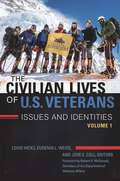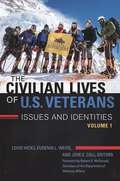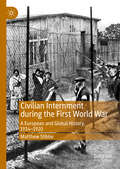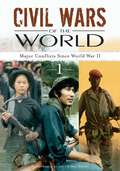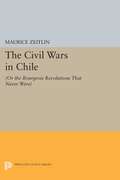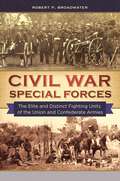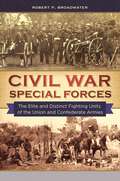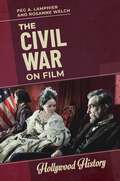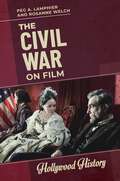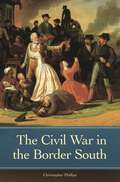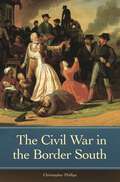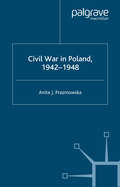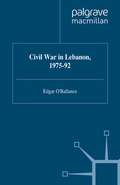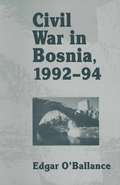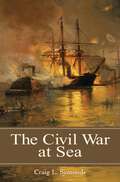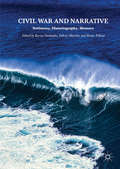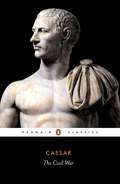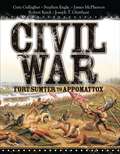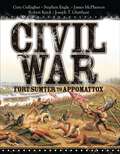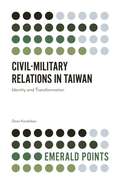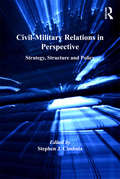- Table View
- List View
The Civilian Lives of U.S. Veterans [2 volumes]: Issues and Identities [2 volumes]
by Louis Hicks, Eugenia L. Weiss, and Jose E. Coll, EditorsIn this book, 50 experts study the lives of U.S. veterans at work, at home, and in American society as they navigate issues regarding health, gender, public service, substance abuse, and homelessness.The aftermath of modern war includes a population of veterans whose needs last for many decades—far longer than the war itself. This in-depth study looks at life after the military, considering the dual conundrum of a population benefiting from the perks of their duty, yet continuing to deal with trauma resulting from their service, and of former servicemen and servicewomen trying to fit into civilian life—in a system designed to keep them separate. Through two comprehensive volumes, essays shed light on more than 30 topics involving or affecting former servicemen and servicewomen, offering a blueprint for the formal study of U.S. veterans in the future. Contributions from dozens of experts in the field of military science cover such issues as unemployment, homelessness, disability, access to higher education, health, media portrayal, criminal justice, substance abuse, guns, suicide, and politics. Through information gleaned from surveys, interviews, participant observations, secondary analyses, and content analyses, the chapters reveal how veterans are able to successfully contribute to civilian life and show how the American workforce can benefit from their unique set of skills.
The Civilian Lives of U.S. Veterans [2 volumes]: Issues and Identities [2 volumes]
In this book, 50 experts study the lives of U.S. veterans at work, at home, and in American society as they navigate issues regarding health, gender, public service, substance abuse, and homelessness.The aftermath of modern war includes a population of veterans whose needs last for many decades—far longer than the war itself. This in-depth study looks at life after the military, considering the dual conundrum of a population benefiting from the perks of their duty, yet continuing to deal with trauma resulting from their service, and of former servicemen and servicewomen trying to fit into civilian life—in a system designed to keep them separate. Through two comprehensive volumes, essays shed light on more than 30 topics involving or affecting former servicemen and servicewomen, offering a blueprint for the formal study of U.S. veterans in the future. Contributions from dozens of experts in the field of military science cover such issues as unemployment, homelessness, disability, access to higher education, health, media portrayal, criminal justice, substance abuse, guns, suicide, and politics. Through information gleaned from surveys, interviews, participant observations, secondary analyses, and content analyses, the chapters reveal how veterans are able to successfully contribute to civilian life and show how the American workforce can benefit from their unique set of skills.
Civilian Internment during the First World War: A European and Global History, 1914—1920
by Matthew StibbeThis book is the first major study of civilian internment during the First World War as both a European and global phenomenon. Based on research spanning twenty-eight archives in seven countries, this study explores the connections and continuities, as well as ruptures, between different internment systems at the local, national, regional and imperial levels. Arguing that the years 1914-20 mark the essential turning point in the transnational and international history of the detention camp, this book demonstrates that wartime civilian captivity was inextricably bound up with questions of power, world order and inequalities based on class, race and gender. It also contends that engagement with internees led to new forms of international activism and generated new types of transnational knowledge in the spheres of medicine, law, citizenship and neutrality. Finally, an epilogue explains how and why First World War internment is crucial to understanding the world we live in today.
Civil Wars of the World [2 volumes]: Major Conflicts since World War II [2 volumes]
This unique two-volume reference is the most authoritative, up-to-date resource available for information and data on the most volatile civil wars around the globe since World War II.At a time when historians are devoting more and more research to conflicts within nations, Civil Wars of the World: Major Conflicts since World War II is an invaluable addition to the available resources. In two volumes, it ranges around the globe to cover the most volatile and deadly civil wars of the past 60 years, including the bloody impasses in the Middle East; devastating tribal warfare in Africa; Cold War–fueled conflicts in Eastern Europe and Asia; the seemingly unbreakable cycle of rebellion and repression in some regions of Latin America; and more.Civil Wars of the World moves country by country to describe the causes, course, and consequences of internal conflicts within each nation. Coverage includes the historical background of each country, geographic and economic factors, descriptions of rebel groups and governments (e.g., regime type, size of military, capacity), terrorism, foreign and/or intergovernmental organization (IGO) intervention (UN, foreign support for rebels), foreign aid, and prospects for peace.
The Civil Wars in Chile: (or The Bourgeois Revolutions that Never Were)
by Maurice ZeitlinThis penetrating sociological study of the causes, consequences, and historical meaning of the civil wars in mid- and late-nineteenth century Chile argues that they were abortive bourgeois revolutions fought out among rival segments of Chile's dominant class. Indeed, it concludes that, in general, not only class but also intraclass struggles can be decisive historically, especially at transitional moments.Originally published in 1984.The Princeton Legacy Library uses the latest print-on-demand technology to again make available previously out-of-print books from the distinguished backlist of Princeton University Press. These editions preserve the original texts of these important books while presenting them in durable paperback and hardcover editions. The goal of the Princeton Legacy Library is to vastly increase access to the rich scholarly heritage found in the thousands of books published by Princeton University Press since its founding in 1905.
Civil War Special Forces: The Elite and Distinct Fighting Units of the Union and Confederate Armies
by Robert P. BroadwaterThis timely addition to Civil War history shares the stories of 25 unique military organizations, showing how past and future collided in the first modern war.The Civil War, of course, pitted North against South. It also pitted ancient ways of war against new, technology-inspired weaponry and tactics. In surveying the war's elite fighting units, this work covers both. The book showcases novel weapons and unorthodox strategies, including machine gunners, rocket battalions, chemical corps, the Union balloon corps, and the Confederate submarine service, all of which harnessed new technologies and were forerunners of the modern military. Chapters also cover archaic special forces, such as lancers and pikers, that had their last hurrah during this transformational conflict.Readers will also meet the fighting youth of the North Carolina Junior Reserves, the "Graybeards" of North Carolina, and the female combatants of the Nancy Harts Militia of Georgia. Going where few other studies have gone, the book fills a gap in existing Civil War literature and brings to life the stories of many of the most extraordinary units that ever served in an American army. The tales it tells will prove fascinating to Civil War and weapons buffs and to general readers alike.
Civil War Special Forces: The Elite and Distinct Fighting Units of the Union and Confederate Armies
by Robert P. BroadwaterThis timely addition to Civil War history shares the stories of 25 unique military organizations, showing how past and future collided in the first modern war.The Civil War, of course, pitted North against South. It also pitted ancient ways of war against new, technology-inspired weaponry and tactics. In surveying the war's elite fighting units, this work covers both. The book showcases novel weapons and unorthodox strategies, including machine gunners, rocket battalions, chemical corps, the Union balloon corps, and the Confederate submarine service, all of which harnessed new technologies and were forerunners of the modern military. Chapters also cover archaic special forces, such as lancers and pikers, that had their last hurrah during this transformational conflict.Readers will also meet the fighting youth of the North Carolina Junior Reserves, the "Graybeards" of North Carolina, and the female combatants of the Nancy Harts Militia of Georgia. Going where few other studies have gone, the book fills a gap in existing Civil War literature and brings to life the stories of many of the most extraordinary units that ever served in an American army. The tales it tells will prove fascinating to Civil War and weapons buffs and to general readers alike.
The Civil War on Film (Hollywood History)
by Peg A. Lamphier Rosanne WelchThe Civil War on Film will inform high school and college readers interested in Civil War film history on issues that arise when film viewers confuse entertainment with historical accuracy.The nation's years of civil war were painful, destructive, and unpleasant. Yet war films tend to embrace mythologies that erase that historical reality, romanticizing the Civil War. The editors of this volume have little patience for any argument that implies race-based slavery isn't an entirely repugnant economic, political, and cultural institution and that the people who fought to preserve slavery were fighting for a glorious and admirable cause.To that end, The Civil War on Film will open with a timeline and introduction and then explore ten films across decades of cinema history in ten chapters, from Birth of a Nation, which debuted in 1915, to The Free State of Jones, which debuted one hundred and one years later. It will also analyze and critique the myriad of mythologies and ideologies which appear in American Civil War films, including Lost Cause ideation, Black Confederate fictions, Northern Aggression mythologies, and White Savior tropes. It will also suggest the way particular films mirror the time in which they were written and filmed. Further resources will close the volume.
The Civil War on Film (Hollywood History)
by Peg A. Lamphier Rosanne WelchThe Civil War on Film will inform high school and college readers interested in Civil War film history on issues that arise when film viewers confuse entertainment with historical accuracy.The nation's years of civil war were painful, destructive, and unpleasant. Yet war films tend to embrace mythologies that erase that historical reality, romanticizing the Civil War. The editors of this volume have little patience for any argument that implies race-based slavery isn't an entirely repugnant economic, political, and cultural institution and that the people who fought to preserve slavery were fighting for a glorious and admirable cause.To that end, The Civil War on Film will open with a timeline and introduction and then explore ten films across decades of cinema history in ten chapters, from Birth of a Nation, which debuted in 1915, to The Free State of Jones, which debuted one hundred and one years later. It will also analyze and critique the myriad of mythologies and ideologies which appear in American Civil War films, including Lost Cause ideation, Black Confederate fictions, Northern Aggression mythologies, and White Savior tropes. It will also suggest the way particular films mirror the time in which they were written and filmed. Further resources will close the volume.
The Civil War in the Border South (Reflections on the Civil War Era)
by Christopher PhillipsThe border states during the Civil War have long been ignored or misunderstood in general histories. This book corrects that oversight, explaining how many border state residents used wartime realities to redefine their politics and culture as "Southern."By studying the characteristics of those positioned along this fault line during the Civil War, the centrality of the war issue of slavery, which border residents long eschewed as being divisive, became apparent. This book explains how the process of Southernization occurred during and after the Civil War—a phenomenon largely unexplained by historians.Beyond the broader, more traditional narrative of the clash of arms, within these border slave states raged an inner civil war that shaped the military and political outcomes of the war as well as these states' cultural landscapes. Author Christopher Phillips describes how the Civil War experience in the border states served to form new loyalties and communities of identity that both deeply divided these states and distorted the meaning of the war for postwar generations.
The Civil War in the Border South (Reflections on the Civil War Era)
by Christopher PhillipsThe border states during the Civil War have long been ignored or misunderstood in general histories. This book corrects that oversight, explaining how many border state residents used wartime realities to redefine their politics and culture as "Southern."By studying the characteristics of those positioned along this fault line during the Civil War, the centrality of the war issue of slavery, which border residents long eschewed as being divisive, became apparent. This book explains how the process of Southernization occurred during and after the Civil War—a phenomenon largely unexplained by historians.Beyond the broader, more traditional narrative of the clash of arms, within these border slave states raged an inner civil war that shaped the military and political outcomes of the war as well as these states' cultural landscapes. Author Christopher Phillips describes how the Civil War experience in the border states served to form new loyalties and communities of identity that both deeply divided these states and distorted the meaning of the war for postwar generations.
Civil War in Poland 1942-1948 (Studies in Russia and East Europe)
by A. PrazmowskaThis challenging new work uses archival research to examine Poland's government in exile during the Second World War as it sought both to fight against the advances of Germany and the Soviet Union, and to prepare for the moment when it would once more be possible to establish a national Polish government. The author suggests that the Poles were as much at war with themselves throughout the war and in the years immediately following the end of hostilities as they were with the German and Soviet forces. Civil War in Poland, 1942-1948 contributes to the debate on the fate of Poland in this complex period, the origins of Communist regimes in Eastern Europe, and the process of transformation in Europe during and since the Second World War.
Civil War in Lebanon, 1975-92
by E. O'BallanceThe sixteen-year long civil war in Lebanon was caused by dissatisfaction over the distribution of political power. The system favoured Christians who fought to eject Palestinian armed forces, which sought to use the country as a spring board for attacks into adjacent Israel. Western intervention was repelled by suicide-bombing attacks. Lebanese Christians and Muslims sub-divided to fight each other. Dominated by competing war lords, this civil war was notable for massacres, treachery, atrocities, kidnapping, assassination, changing alliances of convenience, and invasions.
Civil War in Bosnia 1992–94
by Edgar O'BallanceThe Muslim President of Bosnia battled for almost two years in a 'war the West could not stop', against Serb and Croat separatism, to preserve its entity, saving its sovereignty, but losing half his territory. Western rivalries and changes of policy, endless negotiations, broken promises and cease-fires, and ethnic cleansing on a barbaric scale, with the appearance of concentration camps and atrocities, were the hallmarks of the conflict, of seige, bombardment and starvation, with semi-independent war-loards confiscating a proportion of UN and other food aid for themselves. Rival American and Russian initiatives in March 1994, brought about a cease-fire in Sarajevo, which had been constantly under the television spotlight while being bombarded for almost two years, which it was hoped would spread to other parts of Bosnia in media darkness. Ethnic forward battle lines may become new frontiers.
The Civil War at Sea (Reflections on the Civil War Era)
by Craig L. SymondsThis work provides an assessment of the crucial roles played by the Union and Confederate navies in the Civil War.From Craig Symonds, author of the 2009 Lincoln Prize award-winner Lincoln and His Admirals, comes a fascinating look at the era when American naval power came of age. Thoroughly researched and excitingly written, it brings to light a wealth of new information on a pivotal aspect of the Civil War.The Civil War at Sea covers navies on both sides of the conflict, examining key issues such as the impact of emergent technologies, the effectiveness of the Union's ambitious strategy of blockading, the odyssey of Confederate commerce raiders, the role of naval forces on the western rivers, and the difficulty of conducting combined sea and ground operations against the major Southern port cities. For Civil War buffs, fans of military and technological history, and other interested readers, it is insightful, essential reading.
The Civil War at Sea (Reflections on the Civil War Era)
by Craig L. SymondsThis work provides an assessment of the crucial roles played by the Union and Confederate navies in the Civil War.From Craig Symonds, author of the 2009 Lincoln Prize award-winner Lincoln and His Admirals, comes a fascinating look at the era when American naval power came of age. Thoroughly researched and excitingly written, it brings to light a wealth of new information on a pivotal aspect of the Civil War.The Civil War at Sea covers navies on both sides of the conflict, examining key issues such as the impact of emergent technologies, the effectiveness of the Union's ambitious strategy of blockading, the odyssey of Confederate commerce raiders, the role of naval forces on the western rivers, and the difficulty of conducting combined sea and ground operations against the major Southern port cities. For Civil War buffs, fans of military and technological history, and other interested readers, it is insightful, essential reading.
Civil War and Narrative: Testimony, Historiography, Memory
by Karine Deslandes Fabrice Mourlon Bruno TriboutThis book explores the representation of intra-state conflicts. It offers a distinctive approach by looking at narrative forms and strategies associated with civil war testimony, historiography and memory. The volume seeks to reflect current research in civil war in a number of disciplines and covers a range of geographical areas, from the advent of modern forms of testimonies, history writing and public remembering in the early modern period, to the present day. In focusing on narrative, broadly defined, the contributors not only explore civil war testimonies, historiography and memory as separate fields of inquiry, but also highlight the interplay between these areas, which are shown to share porous boundaries. Chapters look at the ways in which various narrative forms feed off each other, be they oral, written or visual narratives, personal or collective accounts, or testimonies from victims or perpetrators.
Civil War and Narrative: Testimony, Historiography, Memory
by Karine Deslandes Fabrice Mourlon Bruno TriboutThis book explores the representation of intra-state conflicts. It offers a distinctive approach by looking at narrative forms and strategies associated with civil war testimony, historiography and memory. The volume seeks to reflect current research in civil war in a number of disciplines and covers a range of geographical areas, from the advent of modern forms of testimonies, history writing and public remembering in the early modern period, to the present day. In focusing on narrative, broadly defined, the contributors not only explore civil war testimonies, historiography and memory as separate fields of inquiry, but also highlight the interplay between these areas, which are shown to share porous boundaries. Chapters look at the ways in which various narrative forms feed off each other, be they oral, written or visual narratives, personal or collective accounts, or testimonies from victims or perpetrators.
The Civil War: With The Supplementary Books Attr ... To Hirtius, Literally Tr. [by W. A. Macdevitt] With Notes
by Julius CaesarA military leader of legendary genius, Caesar was also a great writer, recording the events of his life with incomparable immediacy and power. The Civil War is a tense and gripping depiction of his struggle with Pompey over the leadership of Republican Rome - a conflict that spanned the entire Roman world, from Gaul and Spain to Asia and Africa. Where Caesar's own account leaves off in 48 BC, his lieutenants take up the history, describing the vital battles of Munda, Spain and Thapsus, and the installation of Cleopatra, later Caesar's mistress, as Queen of Egypt. Together these narratives paint a full picture of the events that brought Caesar supreme power - and paved the way for his assassination only months later.
Civil War: Fort Sumter to Appomattox
by Gary Gallagher Stephen Engle Robert Krick Joseph T. GlatthaarThe four long years of Civil War saw fighting across America on an unprecedented scale, incurring losses to both sides to an extent never previously imagined. As the battles raged from east to west, from the First Battle of Bull run to Sherman's march to the Sea, no part of America remained untouched by the war, with families finding themselves torn and fighting on opposing sides. More than 150 years on, the war continues to fascinate us, and the key commanders, both presidents, and battle sites are forever enshrined in America's history. With a foreword by James McPherson, this volume brings together the work of four leading US historians to provide a thoroughly comprehensive and insightful study of the war, packed with first-hand accounts from soldiers and civilians alike. Superbly illustrated with more than 150 contemporary black-and white and color images, and with 40 specially commissioned full-color maps, this edition provides an analysis of the causes, events, and effects of the Civil War.
Civil War: Fort Sumter to Appomattox
by Gary Gallagher Joseph T. Glatthaar Robert Krick Stephen EngleThe four long years of Civil War saw fighting across America on an unprecedented scale, incurring losses to both sides to an extent never previously imagined. As the battles raged from east to west, from the First Battle of Bull run to Sherman's march to the Sea, no part of America remained untouched by the war, with families finding themselves torn and fighting on opposing sides. More than 150 years on, the war continues to fascinate us, and the key commanders, both presidents, and battle sites are forever enshrined in America's history. With a foreword by James McPherson, this volume brings together the work of four leading US historians to provide a thoroughly comprehensive and insightful study of the war, packed with first-hand accounts from soldiers and civilians alike. Superbly illustrated with more than 150 contemporary black-and white and color images, and with 40 specially commissioned full-color maps, this edition provides an analysis of the causes, events, and effects of the Civil War.
Civil-Military Relations in Taiwan: Identity and Transformation (Emerald Points)
by Dean KaralekasThe armed forces of the Republic of China (ROC) on Taiwan are in dire need of reform to address a plethora of problems including inadequate training, low morale, poor public perception, and low recruitment numbers. This book uses the postmodern military model to measure how public perception of the military is influenced by self-identification in Taiwan, and it shows that the public has little confidence or trust in their military, even as they remain acutely aware of the threat posed by an increasingly belligerent China and its ever-growing People's Liberation Army. While there has been much analysis as to what strategies and weapons systems should be adopted by ROC defense planners, relatively little has been written on how to create a more relevant military within Taiwan society. Ultimately, this book addresses these matters and provides policymakers within the ROC government and military, as well as researchers of Asia Pacific security, with an understanding of the current relationship between military and society, to assist in the creation of a more accountable military.
Civil-Military Relations in Taiwan: Identity and Transformation (Emerald Points)
by Dean KaralekasThe armed forces of the Republic of China (ROC) on Taiwan are in dire need of reform to address a plethora of problems including inadequate training, low morale, poor public perception, and low recruitment numbers. This book uses the postmodern military model to measure how public perception of the military is influenced by self-identification in Taiwan, and it shows that the public has little confidence or trust in their military, even as they remain acutely aware of the threat posed by an increasingly belligerent China and its ever-growing People's Liberation Army. While there has been much analysis as to what strategies and weapons systems should be adopted by ROC defense planners, relatively little has been written on how to create a more relevant military within Taiwan society. Ultimately, this book addresses these matters and provides policymakers within the ROC government and military, as well as researchers of Asia Pacific security, with an understanding of the current relationship between military and society, to assist in the creation of a more accountable military.
Civil-Military Relations in Perspective: Strategy, Structure and Policy
by Stephen J. CimbalaThe topic of civil-military relations has high significance for academics, for policy makers, for military commanders, and for serious students of public policy in democratic and other societies. The post-Cold War and post-9-11 worlds have thrown up traditional as well as new challenges to the effective management of armed forces and defense establishments. Further, the present century has seen a rising arc in the use of armed violence on the part of non-state actors, including terrorists, to considerable political effect. Civil-military relations in the United States, and their implications for US and allied security policies, is the focus of most discussions in this volume, but other contributions emphasize the comparative and cross-national dimensions of the relationship between the use or threat of force and public policy. Authors contributing to this study examine a wide range of issues, including: the contrast between theory and practice in civil-military relations; the role perceptions of military professionals across generations; the character of civil-military relations in authoritarian or other democratically-challenged political systems; the usefulness of business models in military management; the attributes of civil-military relations during unconventional conflicts; the experience of the all-volunteer force and its meaning for US civil-military relations; and other topics. Contributors include civilian academic and policy analysts as well as military officers with considerable academic expertise and experience with the subject matter at hand.
Civil-Military Relations in Perspective: Strategy, Structure and Policy
by Stephen J. CimbalaThe topic of civil-military relations has high significance for academics, for policy makers, for military commanders, and for serious students of public policy in democratic and other societies. The post-Cold War and post-9-11 worlds have thrown up traditional as well as new challenges to the effective management of armed forces and defense establishments. Further, the present century has seen a rising arc in the use of armed violence on the part of non-state actors, including terrorists, to considerable political effect. Civil-military relations in the United States, and their implications for US and allied security policies, is the focus of most discussions in this volume, but other contributions emphasize the comparative and cross-national dimensions of the relationship between the use or threat of force and public policy. Authors contributing to this study examine a wide range of issues, including: the contrast between theory and practice in civil-military relations; the role perceptions of military professionals across generations; the character of civil-military relations in authoritarian or other democratically-challenged political systems; the usefulness of business models in military management; the attributes of civil-military relations during unconventional conflicts; the experience of the all-volunteer force and its meaning for US civil-military relations; and other topics. Contributors include civilian academic and policy analysts as well as military officers with considerable academic expertise and experience with the subject matter at hand.
